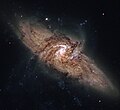Файл:Galactic Silhouettes.jpg

Алдан карауның зурлыгы: 651 × 599 нокта. Башка ачыклык: 261 × 240 нокта | 521 × 480 нокта | 834 × 768 нокта | 1112 × 1024 нокта | 1460 × 1344 нокта.
Төп файл (1460 × 1344 нокта, файл зурлыгы: 1,14 Мб, MIME төре: image/jpeg)
Файл тарихы
Файлның нинди булганлыгын күрү өчен «дата/вакыт» дигәненә басыгыз.
| Дата/вакыт | Кече рәсем | Үлчәмнәре | Кулланучы | Искәрмә | |
|---|---|---|---|---|---|
| агымдагы | 2 гый 2014, 08:40 |  | 1460 × 1344 (1,14 Мб) | Ethically Yours | User created page with UploadWizard |
Файлны куллану
Әлеге файл киләсе битне куллана:
Файлның гомуми кулланышы
Әлеге файл аста бирелгән викиларда куллана:
- ar.wikipedia.org проектында куллану
- arz.wikipedia.org проектында куллану
- ast.wikipedia.org проектында куллану
- az.wikipedia.org проектында куллану
- be-tarask.wikipedia.org проектында куллану
- be.wikipedia.org проектында куллану
- Партал:Астраномія
- Партал:Астраномія/Як я магу дапамагчы
- Галактыка
- Звышскопішча галактык
- Спіральная галактыка
- Шаблон:Галактыкі
- Квазар
- Галактычны цэнтр
- Лінзападобная галактыка
- Спіральная галактыка з перамычкай
- Эліптычная галактыка
- Гравітацыйная лінза
- Галактыка-спадарожнік
- Галактычны год
- Галактычны дыск
- Галактычнае гало
- Галактычны рукаў
- Пекулярная галактыка
- Войд
- Няправільная галактыка
- Скопішча галактык
- Протагалактыка
- Мясцовае звышскопішча галактык
- Вялікі атрактар
- NGC 3314A
- NGC 3314B
- Радыёгалактыка
- Марфалагічная класіфікацыя галактык
- Галактычная перамычка
- Дыскавая галактыка
- Група галактык
- ca.wikipedia.org проектында куллану
- ce.wikipedia.org проектында куллану
- cy.wikipedia.org проектында куллану
- de.wikipedia.org проектында куллану
- diq.wikipedia.org проектында куллану
- en.wikipedia.org проектында куллану
Бу файлның гомуми кулланышын карау.

